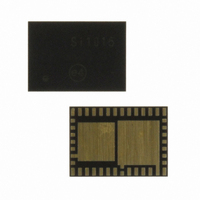SI1015-A-GM Silicon Laboratories Inc, SI1015-A-GM Datasheet - Page 214

SI1015-A-GM
Manufacturer Part Number
SI1015-A-GM
Description
IC TXRX MCU + EZRADIOPRO
Manufacturer
Silicon Laboratories Inc
Specifications of SI1015-A-GM
Package / Case
42-QFN
Frequency
240MHz ~ 960MHz
Data Rate - Maximum
256kbps
Modulation Or Protocol
FSK, GFSK, OOK
Applications
General Purpose
Power - Output
13dBm
Sensitivity
-121dBm
Voltage - Supply
0.9 V ~ 3.6 V
Current - Receiving
18.5mA
Current - Transmitting
30mA
Data Interface
PCB, Surface Mount
Memory Size
8kB Flash, 768B RAM
Antenna Connector
PCB, Surface Mount
Number Of Receivers
1
Number Of Transmitters
1
Wireless Frequency
240 MHz to 960 MHz
Interface Type
UART, SMBus, SPI, PCA
Output Power
13 dBm
Operating Supply Voltage
0.9 V to 3.6 V
Maximum Operating Temperature
+ 85 C
Mounting Style
SMD/SMT
Maximum Supply Current
4 mA
Minimum Operating Temperature
- 40 C
Modulation
FSK, GFSK, OOK
Protocol Supported
C2, SMBus
Core
8051
Program Memory Type
Flash
Program Memory Size
8 KB
Data Ram Size
768 B
Supply Current (max)
4 mA
Lead Free Status / RoHS Status
Lead free / RoHS Compliant
Operating Temperature
-
Lead Free Status / Rohs Status
Lead free / RoHS Compliant
Other names
336-1868-5
Available stocks
Company
Part Number
Manufacturer
Quantity
Price
Company:
Part Number:
SI1015-A-GM
Manufacturer:
Silicon Labs
Quantity:
135
Part Number:
SI1015-A-GM
Manufacturer:
SILICONLA
Quantity:
20 000
- Current page: 214 of 384
- Download datasheet (3Mb)
Si1010/1/2/3/4/5
Notes:
20.3.3. Software Considerations for using the SmaRTClock Timer and Alarm
The SmaRTClock timer and alarm have two operating modes to suit varying applications. The two modes
are described below:
Mode 1:
The first mode uses the SmaRTClock timer as a perpetual timebase which is never reset to zero. Every 36
hours, the timer is allowed to overflow without being stopped or disrupted. The alarm interval is software
managed and is added to the ALRMn registers by software after each alarm. This allows the alarm match
value to always stay ahead of the timer by one software managed interval. If software uses 32-bit unsigned
addition to increment the alarm match value, then it does not need to handle overflows since both the timer
and the alarm match value will overflow in the same manner.
This mode is ideal for applications which have a long alarm interval (e.g., 24 or 36 hours) and/or have a
need for a perpetual timebase. An example of an application that needs a perpetual timebase is one
whose wake-up interval is constantly changing. For these applications, software can keep track of the
number of timer overflows in a 16-bit variable, extending the 32-bit (36 hour) timer to a 48-bit (272 year)
perpetual timebase.
Mode 2:
The second mode uses the SmaRTClock timer as a general purpose up counter which is auto reset to zero
by hardware after each alarm. The alarm interval is managed by hardware and stored in the ALRMn regis-
ters. Software only needs to set the alarm interval once during device initialization. After each alarm, soft-
ware should keep a count of the number of alarms that have occurred in order to keep track of time.
This mode is ideal for applications that require minimal software intervention and/or have a fixed alarm
interval. This mode is the most power efficient since it requires less CPU time per alarm.
214
The ALRM bit, which is used as the SmaRTClock Alarm Event flag, is cleared by disabling
SmaRTClock Alarm Events (RTC0AEN = 0).
If AutoReset is disabled, disabling (RTC0AEN = 0) then Re-enabling Alarm Events (RTC0AEN = 1)
after a SmaRTClock Alarm without modifying ALARMn registers will automatically schedule the next
alarm after 2^32 SmaRTClock cycles (approximately 36 hours using a 32.768 kHz crystal).
The SmaRTClock Alarm Event flag will remain asserted for a maximum of one SmaRTClock cycle. See
Section “14. Power Management” on page 157 for information on how to capture a SmaRTClock Alarm
event using a flag which is not automatically cleared by hardware.
Rev. 1.0
Related parts for SI1015-A-GM
Image
Part Number
Description
Manufacturer
Datasheet
Request
R
Part Number:
Description:
SMD/C°/SINGLE-ENDED OUTPUT SILICON OSCILLATOR
Manufacturer:
Silicon Laboratories Inc
Part Number:
Description:
Manufacturer:
Silicon Laboratories Inc
Datasheet:
Part Number:
Description:
N/A N/A/SI4010 AES KEYFOB DEMO WITH LCD RX
Manufacturer:
Silicon Laboratories Inc
Datasheet:
Part Number:
Description:
N/A N/A/SI4010 SIMPLIFIED KEY FOB DEMO WITH LED RX
Manufacturer:
Silicon Laboratories Inc
Datasheet:
Part Number:
Description:
N/A/-40 TO 85 OC/EZLINK MODULE; F930/4432 HIGH BAND (REV E/B1)
Manufacturer:
Silicon Laboratories Inc
Part Number:
Description:
EZLink Module; F930/4432 Low Band (rev e/B1)
Manufacturer:
Silicon Laboratories Inc
Part Number:
Description:
I°/4460 10 DBM RADIO TEST CARD 434 MHZ
Manufacturer:
Silicon Laboratories Inc
Part Number:
Description:
I°/4461 14 DBM RADIO TEST CARD 868 MHZ
Manufacturer:
Silicon Laboratories Inc
Part Number:
Description:
I°/4463 20 DBM RFSWITCH RADIO TEST CARD 460 MHZ
Manufacturer:
Silicon Laboratories Inc
Part Number:
Description:
I°/4463 20 DBM RADIO TEST CARD 868 MHZ
Manufacturer:
Silicon Laboratories Inc
Part Number:
Description:
I°/4463 27 DBM RADIO TEST CARD 868 MHZ
Manufacturer:
Silicon Laboratories Inc
Part Number:
Description:
I°/4463 SKYWORKS 30 DBM RADIO TEST CARD 915 MHZ
Manufacturer:
Silicon Laboratories Inc
Part Number:
Description:
N/A N/A/-40 TO 85 OC/4463 RFMD 30 DBM RADIO TEST CARD 915 MHZ
Manufacturer:
Silicon Laboratories Inc
Part Number:
Description:
I°/4463 20 DBM RADIO TEST CARD 169 MHZ
Manufacturer:
Silicon Laboratories Inc











